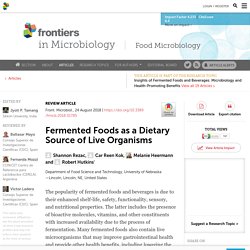

Food Production - Biotechnology - Fermenters - GCSE Biology (9-1) What are food additives? The Power of Food Infographic Animation. Why do we need to change our food system? Can healthy food save the planet? Who can afford to eat sustainably? Climate scientists urge people to eat more plants and less meat to help curb carbon dioxide emissions.

And to help achieve that goal, researchers from around the world launched a guide earlier this year on how to eat sustainably. The original guidelines, called EAT-Lancet, call for diets rich in fruits and vegetables. They recommend that protein and fats come mainly from plant-based foods; unsaturated oils from fish; and carbohydrates from whole grains. EAT-Lancet was exciting, senior researcher at the International Food Policy Research Institute and study lead author Kalle Hirvonen, Ph.D., tells Inverse. “I think we were all very excited to see this dietary recommendation that first time took into account both health of humans and the planet,” says Hirvonen. “At the same time, my co-authors and I have rich experience with working in and on lower income countries so we started to wonder whether people in countries like Ethiopia, Nepal or Nicaragua can actually afford these diets.” Inside the White House: Beer Brewing. FermentedFoods outline rev1029. What are fermented foods? ISAPP educational video (original)
Fermented Foods - International Scientific Association for Probiotics and Prebiotics (ISAPP) What are fermented foods?

Fermented foods have been consumed throughout human history by different cultures around the world. They are defined as foods created through the activity of live microorganisms—and they require a food ‘substrate’ like a vegetable, dairy product, or even a meat product, plus bacteria or yeasts that are either naturally present or are added in order to kick-start the fermentation. The Effects of Unfermented and Fermented Cow and Sheep Milk on the Gut Microbiota. Introduction The old adage “You are what you eat,” now appears to accurately reflect the evidence behind the composition and function of the gut microbiome.

While other factors such as genetics (Turnbaugh et al., 2009) appear to play a part, environmental factors such as diet have amassed a large amount of evidence as to their influence in building and modifying gut microbial communities (Spor et al., 2011; David et al., 2014; Bokulich et al., 2016). The microbiome has a vital and complex symbiotic relationship with their host, and a fine balance between the two appears necessary to maintain optimal health. Although there are limited studies that concretely prove a cause and effect (i.e., is it microbiota dysbiosis that causes disease or disease that shifts the microbiota), a number of health conditions, including obesity, diabetes, and inflammatory bowel disease (IBD), have been linked to shifts in the gut microbiome (Ley et al., 2005; Frank et al., 2007; Cho and Blaser, 2012).
Results. Fermented Foods as a Dietary Source of Live Organisms. Introduction Fermentation has long been used to preserve and enhance the shelf-life, flavor, texture, and functional properties of food (Hutkins, 2018).

More recently, the consumption of fermented foods containing live microorganisms has emerged as an important dietary strategy for improving human health (Marco et al., 2017). 23 Essential Fermented Foods for Better Gut Health. If you haven’t jumped on the fermented foods bandwagon yet, consider this your call to action. Foods like sauerkraut, kimchi, and kombucha have been in the limelight recently for their role in supporting healthy bacteria in your gut. We couldn’t be happier about this fermented resurgence — especially since there’s something for everyone. After all, sourdough, beer, and yogurt are all fermented foods! Start working your way through this list for a super-healthy microbiome.
Kefir is like a tangy drinkable yogurt, and all you need to make your own version at home is whole milk and kefir grains, which are easily found online. With all the delicious kombucha flavors out there, it’s sometimes easy to forget that it’s actually made from sweetened tea. No, these pickles don’t have milk in them. If you’ve never tried kvass before, you’re in for a treat. One of the most-recognized and well-loved fermented foods is kimchi. Think of this like the perfect combination of kombucha and ginger ale. WELCOME TO THE PSC100 SECTION. Abstract Launched in 2011, the PSC100 group comprises caterers, dietitians, politicians, healthy eating campaigners and suppliers who operate in the public sector and use their collective 'clout' to drive government legislation and action towards helping people adopt healthier lifestyles through catering and education initiatives.

It is chaired by Andy Jones, former chair of the Hospital Caterers Association (HCA), and as well as commissioning research into health and nutrition, it holds seminars offering updates on healthy eating, obesity and malnutrition and supports all initiatives with similar aims. The group focus is currently on how caterers in the workplace, universities, schools, hospitals, care homes and prisons can help cut the amount of sugar in our diets. The group is an evolution of Public Sector Catering magazine's annual celebration of the work and achievements of the best operators in the business - the Public Sector Catering Most Influential Top 20.